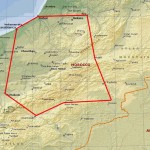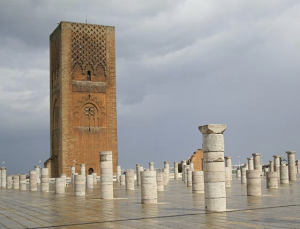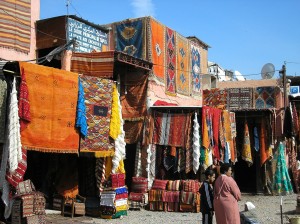We are off to Morocco on December 11th. Since I knew nothing about this country other than we loved the Moroccan influence in Spain and wanted to know more. Below is “briefly“ what we found checking the US State Department website and Wikipedia (thanks Ashe).
GEOGRAPHY
Location: North Africa, bordering the Atlantic Ocean and the Mediterranean Sea, southern border with Western Sahara, eastern border with Algeria.
Area: 446,550 sq. km. (172,413 sq. mi.) slightly larger than California. (The disputed territory of Western Sahara comprises another 267,028 sq. km. or 102,703 sq. mi.)
Climate: Mediterranean to more extreme in the interior and south.
Land use: Arable land, 19%; permanent crops, 2%; other, 79%.
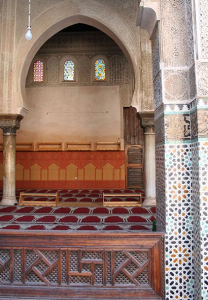 ETHNOLOGY
ETHNOLOGY
Nationality: Noun and adjective–Moroccan(s)
Population (July 2009 est.): 34,859,364. (The population of disputed territory Western Sahara is 385,000.)
Ethnic groups: Arab-Berber 99.1%, other 0.7%, Jewish 0.2%.
Religions: Muslim 98.7%, Christian 1.1%, Jewish 0.2%.
Languages: Arabic (official), several Berber dialects; French functions as the language of business, government, and diplomacy.
Education: Years compulsory–9. Literacy (definition–age 15 and over can read and write)
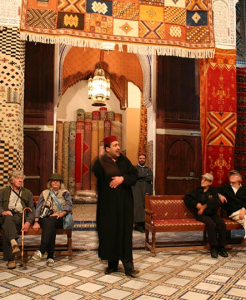 PEOPLE
PEOPLE
Moroccans are predominantly Sunni Muslims of Arab, Berber, or mixed Arab-Berber ancestry. The Arabs brought Islam, along with Arabic language and culture, to the region from the Arabian Peninsula during the Muslim conquests of the 7th century. Today, a small Jewish community remains as well as a very small ex-patriate Christian population; all enjoy religious freedom and full civil rights.
Arabic is the official language, but French is widely taught and serves as the primary language of commerce and government. Moroccan colloquial Arabic, Darija, is composed of a unique combination of Arabic, Berber, and French dialects. Along with Arabic, about 10 million Moroccans, predominantly in rural areas, also speak one of the three Moroccan Berber dialects (Tarifit, Tashelhit, and Tamazight). Spanish is also used in the northern part of the country. Increasingly English is becoming the foreign language of choice among educated youth and is offered from the fourth year on in many public schools.
Most people live west of the Atlas Mountains, a range that insulates the country from the Sahara Desert. Casablanca is the center of commerce and industry and the leading port; Rabat is the seat of government; Tangier is the gateway to Spain and also a major port; “Arab” Fes is the cultural and religious center; and “Berber” Marrakech is a major tourist center.
Education in Morocco is free and compulsory through primary school (age 15). Nevertheless, many children–particularly girls in rural areas–do not attend school, and most of those who do, drop out after elementary school. The country’s literacy rate reveals sharp gaps in education, both in terms of gender and location; while country-wide literacy rates are estimated at 39.6% among women and 65.7% among men, the female literacy rate in rural areas is estimated only at 10%.
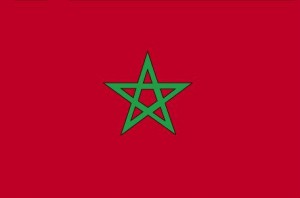
GOVERNMENT
Type: Constitutional monarchy.
Constitution: March 1972, revised 1980, 1992, and 1996 (creating a bicameral legislature).
Independence: March 2, 1956.
Branches: Executive–king (head of state), prime minister (head of government). Legislative–bicameral Parliament. Judicial–Supreme Court.
Suffrage: Universal starting at 18 years of age.
HISTORY
The area of present day Morocco has been inhabited since Neolithic times (at least since 2000 BC, as attested by archeological remnants of the Capsian culture). This was a period when the Maghreb was less arid than it is today. In Mesolithic ages the geography of Morocco resembled a savanna unlike the present day arid landscape.
 Morocco’s strategic location has shaped its history. North Africa and Morocco were slowly drawn into the wider emerging Mediterranean world by Phoenician trading colonies and settlements in the early Classical period. Early substantial settlements of the Phoenicians were at Chellah, Lixus and Mogador, with Mogador considered Phoenician colony as early as the early 6th century BC. The arrival of Phoenicians heralded a long engagement with the wider Mediterranean, as this strategic region formed part of the Roman Empire, as Mauretania Tingitana. In the fifth century, as the Roman Empire declined, the region fell to the Vandals, Visigoths, and then the Byzantine Empire, the Eastern Roman Empire, in rapid succession. During this time, however, populations in the high mountains of most of modern Morocco remained unsubdued, and stayed under control of their Berber inhabitants.
Morocco’s strategic location has shaped its history. North Africa and Morocco were slowly drawn into the wider emerging Mediterranean world by Phoenician trading colonies and settlements in the early Classical period. Early substantial settlements of the Phoenicians were at Chellah, Lixus and Mogador, with Mogador considered Phoenician colony as early as the early 6th century BC. The arrival of Phoenicians heralded a long engagement with the wider Mediterranean, as this strategic region formed part of the Roman Empire, as Mauretania Tingitana. In the fifth century, as the Roman Empire declined, the region fell to the Vandals, Visigoths, and then the Byzantine Empire, the Eastern Roman Empire, in rapid succession. During this time, however, populations in the high mountains of most of modern Morocco remained unsubdued, and stayed under control of their Berber inhabitants.
MOOR IN MOROCCO
Islamic expansion began in the seventh century. In 670 AD, the first Islamic conquest of the North African coastal plain took place under Uqba ibn Nafi, a Damascan general who served under the Caliphate of Umayyads, one of the four Islamic caliiphates established at the death of Muhammed. Arabs brought with them their customs, culture, and religion. It was in this period that most Berbers converted to Islam. These conquering Arabs along with the Berbers then formed states and kingdoms such as the Kingdom of Nekor and Barghwata.
After long-running series of civil wars between these states and kingdoms, the Idrisid Dynasty was founded by Idris I who had escaped from Syria and had taken refuge in Morocco. He soon cut ties and broke away from the control of the distant Baghdad and Damascus caliphs. The Idrisids established Fes as their capital and Morocco became a centre of learning and a major regional power.
After the reign of the Idrisids, Arab settlers lost political control in the region of Morocco. After adopting Islam, Berber dynasties formed governments and reigned over the country. Morocco would reach its height under these Berber dynasties that replaced the Arab Idrisids after the 11th century. The Almoravids, the Almohads, then the Marinid and finally the Saadi dynasties would see Morocco rule most of Northwest Africa, as well as large sections of Islamic Iberia, or Al-Andalus. Following the Reconquista of the Iberian Peninsula, large numbers of Muslims and fled to Morocco.
Once again Morocco’s location and resources led to early competition among European powers in Africa. Beginning with successful Portuguese efforts to dominate the Atlantic coast in the 15th century. France showed a strong interest in Morocco beginning as early as 1830. French authority was strengthened following recognition by the United Kingdom in 1904 of France’s “sphere of influence” in Morocco, the Algeciras Conference (1906) formalized France’s “special position” and entrusted policing of Morocco to France and Spain jointly. The Treaty of Fes (1912) made Morocco a protectorate of France. By the same treaty, Spain assumed the role of protecting power over the northern and southern (Saharan) zones.
POST WORLD WAR II
Nationalist political parties, which took shape in the French protectorate period, began a strong campaign for independence after World War II. A manifesto of the Istiqlal (Independence) Party in 1944 was one of the earliest public demands for independence. That party subsequently provided most of the leadership for the nationalist movement and remains a strong political party.
In 1953, France exiled the highly respected Sultan Mohammed V and replaced him with the unpopular Mohammed Ben Aarafa. Ben Aarafa’s reign was widely perceived as illegitimate, and sparked active opposition to French rule. France allowed Mohammed V to return in 1955, and by 1956, Morocco had regained its independence.
In 2006, Moroccans celebrated their 50th year of independence from France. After gaining independence on March 2, 1956, Morocco regained control over certain Spanish-ruled areas through agreements with Spain in 1956 and 1958. The internationalized city of Tangier was reintegrated into Morocco with the signing of the Tangier Protocol on October 29, 1956. The Spanish enclave of Ifni in the south became part of Morocco in 1969. Spain, however, retains control over the small coastal enclaves of Ceuta and Melilla in the north.
During the 1990s, King Hassan made great strides toward economic and political liberalization. King Hassan died on July 23, 1999, and was succeeded by his son, Mohammed VI, who pledged to continue these reforms. Under Mohammed VI, the Moroccan Government has undertaken a number of economic, social, and political reforms, including the 2003 Moudawana, a reform of the family status code, and the 2006 Equity and Reconciliation Commission, which investigated allegations of human rights abuse from 1956 to 1999.
GOVERNMENT AND POLITICAL CONDITIONS
Morocco is divided into 16 administrative regions (further broken into provinces and prefectures); the regions are administered by walis (governors) appointed by the king.
The Moroccan constitution provides for a strong monarchy but a weak Parliament and judicial branch. Dominant authority rests with the king. The king presides over the Council of Ministers; appoints the prime minister following legislative elections; appoints all members of the government taking into account the prime minister’s recommendations; and may, at his discretion, terminate the tenure of any minister, dissolve the Parliament, call for new elections, or rule by decree. The king is the commander in chief of the military and holds the title of Amir al-Mou’minin, or Commander of the Faithful, the country’s religious leader.
Since the constitutional reform of 1996, the bicameral legislature consists of a lower chamber called the Chamber of Representatives, which is directly elected, and an upper chamber, the Chamber of Counselors, whose members are indirectly elected through various regional, local, and professional councils. The councils’ members themselves are directly elected. Parliament’s powers are limited, but were expanded under the 1992 and 1996 constitutional revisions to include some budgetary matters, approval authority, and establishment of commissions of inquiry to investigate the government’s actions. Though never used, the lower chamber of Parliament may dissolve the government through a majority vote of no confidence.
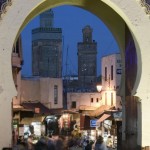 Beginning early in his reign, King Mohammed VI called for expanded employment opportunities, economic development, meaningful education, and increased housing availability. His government has been pursuing an ambitious program of modernization and revitalization of the country’s infrastructure (such as roads, trains, communications, and water) and national economy (such as support for Moroccan businesses, preparations for competition, and modernization of modes of production).
Beginning early in his reign, King Mohammed VI called for expanded employment opportunities, economic development, meaningful education, and increased housing availability. His government has been pursuing an ambitious program of modernization and revitalization of the country’s infrastructure (such as roads, trains, communications, and water) and national economy (such as support for Moroccan businesses, preparations for competition, and modernization of modes of production).
In order to create employment opportunities, the government is promoting investment in the tourism, manufacturing, fishing, and service industries. In 2002 the government began the Tangier-Med port project, aimed at promoting the north’s development and enhancing trade with Europe and the rest of the world. The new port complex, located at the crossroads of major sea routes, targets international markets of 600 million people including Western Europe, North Africa, and North America.
The Moroccan economy has been characterized by macroeconomic stability, with generally low inflation and sustained, moderately high growth rates over the past several years. Recent governments have pursued reform, liberalization, and modernization aimed at stimulating growth and creating jobs. Morocco’s primary economic challenge is to accelerate growth and sustain that improved performance in order to reduce high levels of unemployment and underemployment. While overall unemployment stands at 9.9% (2009 est.), this figure masks significantly higher urban unemployment, as high as 33% among urban youths.
 While economic growth has historically been hampered by volatility in the rainfall-dependent agriculture sector, diversification has made the economy a bit more resilient. In 2007, continued strong performance by non-agricultural sectors ensured a positive growth rate, even as agricultural production contracted by nearly 20%. Since that time, agriculture has recovered, with adequate rainfall, increasing 25% over a 2-year period. GDP growth fell slightly from 5.6 % in 2008 to 5.1 % in 2009. In 2010, GDP is expected to grow at a 4.5% rate.
While economic growth has historically been hampered by volatility in the rainfall-dependent agriculture sector, diversification has made the economy a bit more resilient. In 2007, continued strong performance by non-agricultural sectors ensured a positive growth rate, even as agricultural production contracted by nearly 20%. Since that time, agriculture has recovered, with adequate rainfall, increasing 25% over a 2-year period. GDP growth fell slightly from 5.6 % in 2008 to 5.1 % in 2009. In 2010, GDP is expected to grow at a 4.5% rate.
FOREIGN RELATIONS
Morocco is a moderate Arab state which maintains close relations with Europe and the United States. It is a member of the UN and belongs to the Arab League, Arab Maghreb Union (UMA), Organization of the Islamic Conference (OIC), the Non-Aligned Movement, and the Community of Sahel-Saharan States (CEN-SAD). King Mohammed VI is the chairman of the OIC’s Al-Quds (Jerusalem) Committee. Although not a member of the African Union (formerly the Organization of African Unity–OAU), Morocco remains involved in African diplomacy. It contributes consistently to UN peacekeeping efforts on the continent.
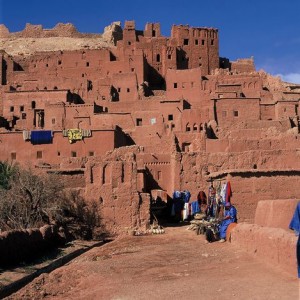 In addition to traditional security measures, King Mohammed VI has promoted significant initiatives to counter extremism and dissuade individuals from becoming radicalized. Each Ramadan, for example, the King hosts a series of religious lectures, inviting Muslim speakers from around the world to promote moderate and peaceful religious interpretations. The religious reform launched in 2005 included training of the Ulema (religious scholars) Council and the retraining of imams (prayer leaders) to ensure improved academic background and performance in the fields of education and counseling in religious matters, social conduct, and pious behavior. The reforms included women as stakeholders by training a number of women as counselors, preachers, and supervisors to improve conditions for women, counsel young girls, and instill a sense of strong commitment to Islam’s tolerant ideals. In his 2009 Throne Day speech, the King highlighted the moderate and tolerant nature of the Sunni Malekite rite, which, he emphasized, forms an integral part of Moroccan identity.
In addition to traditional security measures, King Mohammed VI has promoted significant initiatives to counter extremism and dissuade individuals from becoming radicalized. Each Ramadan, for example, the King hosts a series of religious lectures, inviting Muslim speakers from around the world to promote moderate and peaceful religious interpretations. The religious reform launched in 2005 included training of the Ulema (religious scholars) Council and the retraining of imams (prayer leaders) to ensure improved academic background and performance in the fields of education and counseling in religious matters, social conduct, and pious behavior. The reforms included women as stakeholders by training a number of women as counselors, preachers, and supervisors to improve conditions for women, counsel young girls, and instill a sense of strong commitment to Islam’s tolerant ideals. In his 2009 Throne Day speech, the King highlighted the moderate and tolerant nature of the Sunni Malekite rite, which, he emphasized, forms an integral part of Moroccan identity.
Morocco’s top foreign relations priority is its claim to Western Sahara. Relations with sub-Saharan African countries have been complicated by the Western Sahara issue, as many African states recognize the Saharawi Arab Democratic Republic (SADR) government-in-exile of the Frente Popular para la Liberacion de Saguia El-Hamra y Rio de Oro (Polisario) as the territory’s legitimate government. As a result of Algeria’s continued support for the Polisario Front in the dispute over Western Sahara, relations between Morocco and Algeria have remained strained over the past several decades, although the two countries have full diplomatic relations with periodic high-level contact. The African Union also recognizes the SADR, and Morocco withdrew from its predecessor, the OAU, in 1984 in protest. Nevertheless, Morocco maintains close relations with numerous, mostly francophone states in West and Central Africa.
DISPUTED WESTERN SAHARA
For more than 30 years, Morocco and the independence-seeking Polisario have vied for control of the Western Sahara, a former Spanish territory. Morocco’s claim to sovereignty over the Western Sahara is based largely on a historical argument of traditional loyalty of Sahrawi tribal leaders to the Moroccan sultan. The Polisario claims to represent the aspirations of the inhabitants of Western Sahara for independence.
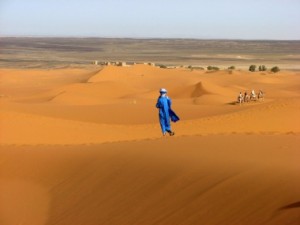 From 1904 until 1975, Spain occupied the entire territory, which is divided into a northern portion, the Saguia el Hamra, and a southern two-thirds, the Rio de Oro. In 1969, the Polisario Front was formed to combat the occupation of the territory. In November 1975, King Hassan mobilized 350,000 unarmed Moroccan citizens in what came to be known as the “Green March” into Western Sahara. The march was designed to both demonstrate and strengthen Moroccan claims to the territory, and it is celebrated to this day. On November 14, Spain, Morocco, and Mauritania announced a tripartite agreement for an interim administration under which Spain agreed to share administrative authority with Morocco and Mauritania, leaving aside the question of sovereignty. With the establishment of a Moroccan and Mauritanian presence throughout the territory, however, Spain’s role in the administration of the Western Sahara effectively ceased.
From 1904 until 1975, Spain occupied the entire territory, which is divided into a northern portion, the Saguia el Hamra, and a southern two-thirds, the Rio de Oro. In 1969, the Polisario Front was formed to combat the occupation of the territory. In November 1975, King Hassan mobilized 350,000 unarmed Moroccan citizens in what came to be known as the “Green March” into Western Sahara. The march was designed to both demonstrate and strengthen Moroccan claims to the territory, and it is celebrated to this day. On November 14, Spain, Morocco, and Mauritania announced a tripartite agreement for an interim administration under which Spain agreed to share administrative authority with Morocco and Mauritania, leaving aside the question of sovereignty. With the establishment of a Moroccan and Mauritanian presence throughout the territory, however, Spain’s role in the administration of the Western Sahara effectively ceased.
After a period of hostilities, Mauritania withdrew from the territory in 1979 and signed a peace treaty with the Polisario, relinquishing all claims to the territory.
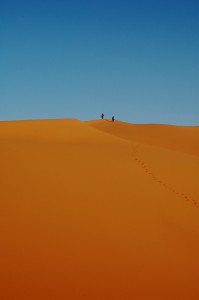 In 1988, Moroccan and Polisario representatives agreed on a joint UN/OAU settlement proposal for a referendum, but, due to disagreements over who could vote and what options of self-determination could be voted on, it never took place. In 1991, the UN brokered a cease-fire and settlement plan and established the United Nations Mission for the Referendum in Western Sahara (known by its French acronym, MINURSO), which deployed a roughly 200-person monitoring force to the territory.
In 1988, Moroccan and Polisario representatives agreed on a joint UN/OAU settlement proposal for a referendum, but, due to disagreements over who could vote and what options of self-determination could be voted on, it never took place. In 1991, the UN brokered a cease-fire and settlement plan and established the United Nations Mission for the Referendum in Western Sahara (known by its French acronym, MINURSO), which deployed a roughly 200-person monitoring force to the territory.
The Western Sahara dispute remains the primary impediment to regional integration and development goals and Moroccan-Algerian relations. The parties were able to set aside some of their differences when, in August 2004, U.S. Senator Richard Lugar led a mission to the region that resulted in the release of 404 Moroccan prisoners of war who had long been held by the Polisario. Today, approximately 90,000 Sahrawi refugees live in camps around Tindouf, Algeria. The exact number of refugees living in these camps is not known, since there has never been a reliable census of the population. Several thousand Sahrawis also live in the Moroccan-controlled area of Western Sahara among a large number of Moroccan settlers. Morocco considers the Western Sahara part of its national territory, while the Polisario, with Algerian support, insists on the right of the people of the Western Sahara to self-determination. The UN continues to explore with the parties ways of arriving at a mutually agreed political settlement and to promote confidence-building measures between the parties in the interim.
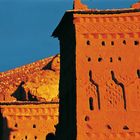
U.S.-MOROCCAN RELATIONS
Morocco was the first country to seek diplomatic relations with the Government of the United States in 1777 and remains one of our oldest and closest allies in the region. Formal U.S. relations with Morocco date from 1787, when the two nations negotiated a Treaty of Peace and Friendship. Morocco was the first nation to recognize the fledgling United States as an independent nation in 1787. In the beginning of the American Revolution, American merchant ships were subject to attack by the Barbary Pirates while sailing the Atlantic Ocean. On December 20, 1777, Morocco’s Sultan Mohammed III declared that the American merchant ships would be under the protection of the sultanate and could thus enjoy safe passage. The Moroccan-American Treaty of Friendship stands as the U.S.’s oldest non-broken friendship treaty. Renegotiated in 1836, the treaty is still in force, constituting the longest unbroken treaty relationship in U.S. history. As a stable, comparatively moderate Arab Muslim nation, Morocco is important for U.S. interests in the Middle East.
The Peace Corps has been active in Morocco for more than 40 years, with the first group of 53 volunteers arriving in the country in 1963. Since that time, nearly 4,000 volunteers have served in Morocco in a variety of capacities including lab technology, urban development, commercial development, education, rural water supply, small business development, beekeeping, and English language training. In 2009, 254 volunteers served in Morocco, working in four sectors: health, youth development, small business, and English literacy.
